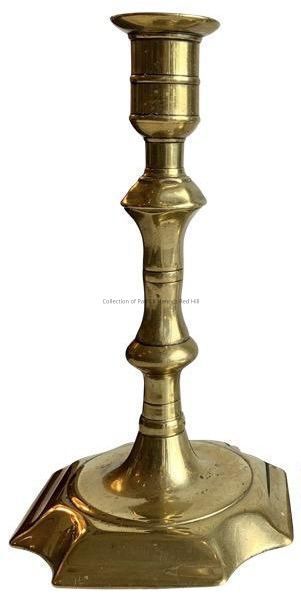Notes
This is a c.1730 cast brass candlestick, made in the Queen Anne style in England.
Candlestick-casting technology had advanced in the 18th century. The stems with their integral sockets were cast in halves in the lengthwise dimension in cavities formed with wooden patterns relieved or hollowed on the inside surface. These cast halves were then brazed together to form complete, hollow stems ready for finishing. Evidence of this technique is visible on many candlesticks throughout the 18th and into the early 19th centuries, including this one. This evidence is in the form of parallel braze lines on opposite sides of a candlestick stem.
The stem is fastened to the base by peening. The base has been lathe-turned to thin the base and to recover metal. The process of metal recovery carried over from early candlestick-making and continued throughout the 18th century.
The interior candle ejector can be moved via a threaded connection in the base. When the base is twisted, the ejector rises or falls for the easy removal of candle stubs.
This candlestick, along with its twin, are similar to what Patrick Henry used at Red Hill. According to Henry's 1799 estate inventory, "7 candle sticks" were present. His 1802 inventory more specifically lists "3 nice brass candlesticks" in addition to "4 iron candlesticks."
This candlestick was purchased as a set with its twin (2023.49.2) by PHMF using funds from the estate of Dr. Bruce English on December 15, 2023.
